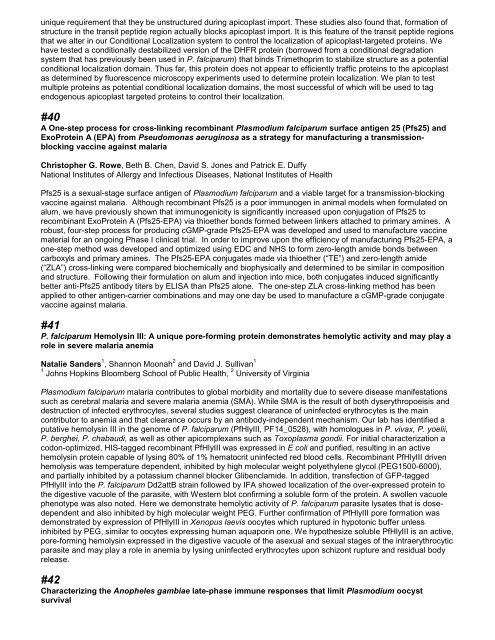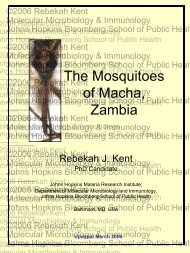Conference Program - Johns Hopkins Malaria Research Institute ...
Conference Program - Johns Hopkins Malaria Research Institute ...
Conference Program - Johns Hopkins Malaria Research Institute ...
You also want an ePaper? Increase the reach of your titles
YUMPU automatically turns print PDFs into web optimized ePapers that Google loves.
unique requirement that they be unstructured during apicoplast import. These studies also found that, formation of<br />
structure in the transit peptide region actually blocks apicoplast import. It is this feature of the transit peptide regions<br />
that we alter in our Conditional Localization system to control the localization of apicoplast-targeted proteins. We<br />
have tested a conditionally destabilized version of the DHFR protein (borrowed from a conditional degradation<br />
system that has previously been used in P. falciparum) that binds Trimethoprim to stabilize structure as a potential<br />
conditional localization domain. Thus far, this protein does not appear to efficiently traffic proteins to the apicoplast<br />
as determined by fluorescence microscopy experiments used to determine protein localization. We plan to test<br />
multiple proteins as potential conditional localization domains, the most successful of which will be used to tag<br />
endogenous apicoplast targeted proteins to control their localization.<br />
#40<br />
A One-step process for cross-linking recombinant Plasmodium falciparum surface antigen 25 (Pfs25) and<br />
ExoProtein A (EPA) from Pseudomonas aeruginosa as a strategy for manufacturing a transmissionblocking<br />
vaccine against malaria<br />
Christopher G. Rowe, Beth B. Chen, David S. Jones and Patrick E. Duffy<br />
National <strong>Institute</strong>s of Allergy and Infectious Diseases, National <strong>Institute</strong>s of Health<br />
Pfs25 is a sexual-stage surface antigen of Plasmodium falciparum and a viable target for a transmission-blocking<br />
vaccine against malaria. Although recombinant Pfs25 is a poor immunogen in animal models when formulated on<br />
alum, we have previously shown that immunogenicity is significantly increased upon conjugation of Pfs25 to<br />
recombinant ExoProtein A (Pfs25-EPA) via thioether bonds formed between linkers attached to primary amines. A<br />
robust, four-step process for producing cGMP-grade Pfs25-EPA was developed and used to manufacture vaccine<br />
material for an ongoing Phase I clinical trial. In order to improve upon the efficiency of manufacturing Pfs25-EPA, a<br />
one-step method was developed and optimized using EDC and NHS to form zero-length amide bonds between<br />
carboxyls and primary amines. The Pfs25-EPA conjugates made via thioether (“TE”) and zero-length amide<br />
(“ZLA”) cross-linking were compared biochemically and biophysically and determined to be similar in composition<br />
and structure. Following their formulation on alum and injection into mice, both conjugates induced significantly<br />
better anti-Pfs25 antibody titers by ELISA than Pfs25 alone. The one-step ZLA cross-linking method has been<br />
applied to other antigen-carrier combinations and may one day be used to manufacture a cGMP-grade conjugate<br />
vaccine against malaria.<br />
#41<br />
P. falciparum Hemolysin III: A unique pore-forming protein demonstrates hemolytic activity and may play a<br />
role in severe malaria anemia<br />
Natalie Sanders 1 , Shannon Moonah 2 and David J. Sullivan 1<br />
1 <strong>Johns</strong> <strong>Hopkins</strong> Bloomberg School of Public Health, 2 University of Virginia<br />
Plasmodium falciparum malaria contributes to global morbidity and mortality due to severe disease manifestations<br />
such as cerebral malaria and severe malaria anemia (SMA). While SMA is the result of both dyserythropoeisis and<br />
destruction of infected erythrocytes, several studies suggest clearance of uninfected erythrocytes is the main<br />
contributor to anemia and that clearance occurs by an antibody-independent mechanism. Our lab has identified a<br />
putative hemolysin III in the genome of P. falciparum (PfHlyIII, PF14_0528), with homologues in P. vivax, P. yoelii,<br />
P. berghei, P. chabaudi, as well as other apicomplexans such as Toxoplasma gondii. For initial characterization a<br />
codon-optimized, HIS-tagged recombinant PfHlyIII was expressed in E coli and purified, resulting in an active<br />
hemolysin protein capable of lysing 80% of 1% hematocrit uninfected red blood cells. Recombinant PfHlyIII driven<br />
hemolysis was temperature dependent, inhibited by high molecular weight polyethylene glycol (PEG1500-6000),<br />
and partially inhibited by a potassium channel blocker Glibenclamide. In addition, transfection of GFP-tagged<br />
PfHlyIII into the P. falciparum Dd2attB strain followed by IFA showed localization of the over-expressed protein to<br />
the digestive vacuole of the parasite, with Western blot confirming a soluble form of the protein. A swollen vacuole<br />
phenotype was also noted. Here we demonstrate hemolytic activity of P. falciparum parasite lysates that is dosedependent<br />
and also inhibited by high molecular weight PEG. Further confirmation of PfHlyIII pore formation was<br />
demonstrated by expression of PfHlyIII in Xenopus laevis oocytes which ruptured in hypotonic buffer unless<br />
inhibited by PEG, similar to oocytes expressing human aquaporin one. We hypothesize soluble PfHlyIII is an active,<br />
pore-forming hemolysin expressed in the digestive vacuole of the asexual and sexual stages of the intraerythrocytic<br />
parasite and may play a role in anemia by lysing uninfected erythrocytes upon schizont rupture and residual body<br />
release.<br />
#42<br />
Characterizing the Anopheles gambiae late-phase immune responses that limit Plasmodium oocyst<br />
survival



